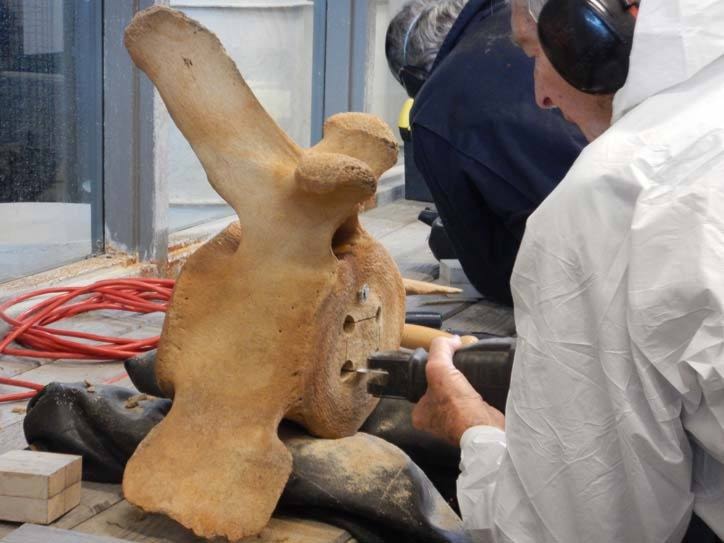Vancouver Island University’s innovative buy-a-bone-to-raise-a-whale campaign is sold out, but public support is still needed to create a permanent educational exhibit at the Deep Bay Marine Field Station north of Parksville.
“We’re ecstatic and truly overwhelmed at the public enthusiasm towards this project,” said Brian Kingzett, field station manager. “All 156 whale bones have been sponsored and we’ve raised $67,000 thanks to the generous support of individuals and businesses in our community.
“Our staff and volunteers are hard at work preparing the final exhibit, but we need to raise another $8,000 to complete it by March. The exhibit will feature a 35-foot grey whale skeleton hanging over the stairwell of the field station. It will be the highlight of our marine science public education program.”
Certificates of ‘bone ownership’ signed by VIU President and Vice-Chancellor Ralph Nilson are being mailed to all donors who purchased bones and supported the online campaign. Nanaimo dentist Rob Wolanski, a member of the VIU Foundation Board, purchased two lumbar vertebrae and one thoracic vertebrae to show his support for the project.
“I wanted the whale’s jaw bone but it was already sold,” says Wolanski, who works at Vancouver Island Implant Centre in Nanaimo. “When I heard there were three bones left, I thought why not? I bought them all because I know how hard it is to sell the last few items in any fundraising campaign. I also know how many people have volunteered their time in order to leave a legacy for future generations. This truly is a fantastic project.”
Launched by the VIU Foundation and Deep Bay Marine Field Station last spring, the raise-a-whale campaign received a major boost when the Underwater Harvesters Association became a lead donor by making a $10,000 gift to the project.
That donation, plus the purchase of all 23 bones in the whale’s tail by Jamie’s Whaling Station of Tofino, pushed the campaign past the half way mark. A host of other donors stepped up, from VIU employees, to retired marine scientists, to community members, who supported the cause by sponsoring bones.
Kingzett came up the idea of creating a permanent whale skeleton exhibit at the field station after the remains of a 20-plus-tonne grey whale washed up on the beach in Sooke, at the south end of Vancouver Island in April 2010.
Together with Fisheries and Oceans Canada, VIU worked in partnership with the Scia’new First Nation to bury the whale on their land in the hopes that it could be used in the future for an educational purpose.
After a four-year decomposition process, the whale skeleton was exhumed last June. The bones were transported to labs at the field station where they were cleaned and dried over the summer. Visitors to the field station have been able to watch a consultant and a team of volunteers prepare the bones for the final exhibit.
“It’s combination of science, engineering and art,” said Kingzett. “Intensive cleaning processes are required and oils must be removed from the bones before they are assembled into a natural looking display. Over the past few weeks, we’ve been drilling holes into the bones because a steel rod will hold the skeleton together when it hangs from the ceiling inside the station.
“The exhibit will complement what we do, especially in terms of educating the public about sustainability in coastal communities,” Kingzett added.
For more information about the project or to view photos of the bone articulation process, please visit http://viudeepbay.com/.
If anyone would like to get involved or make a contribution, please e-mail Brian.Kingzett@viu.ca.
